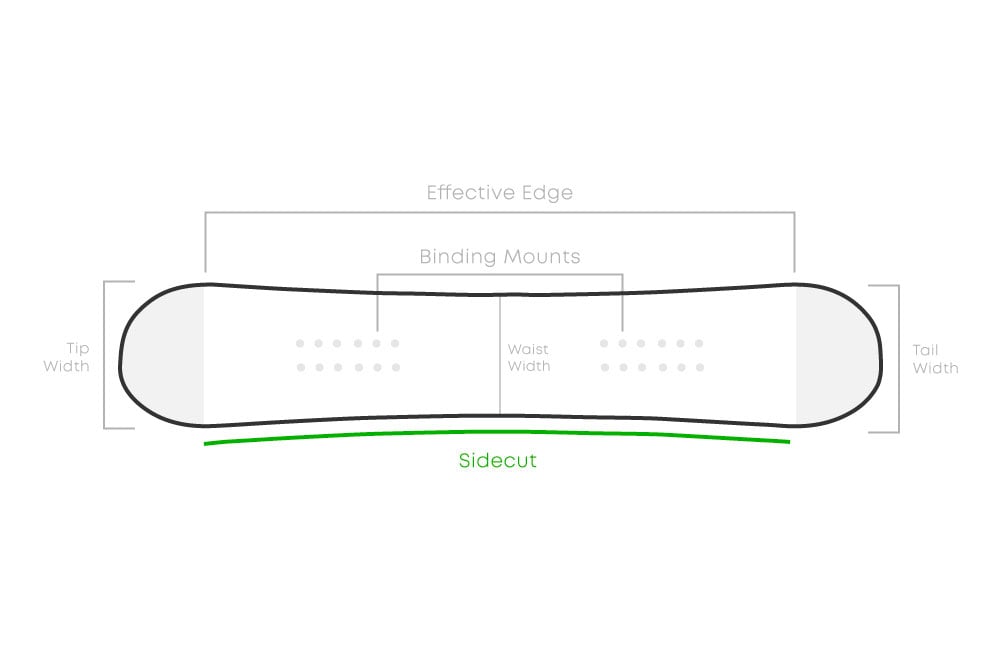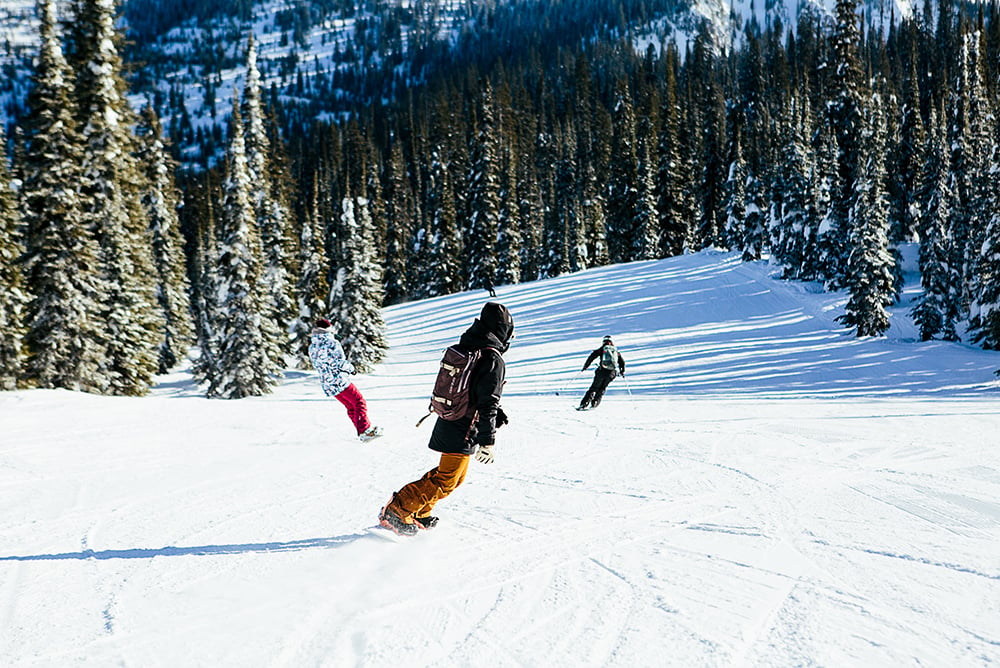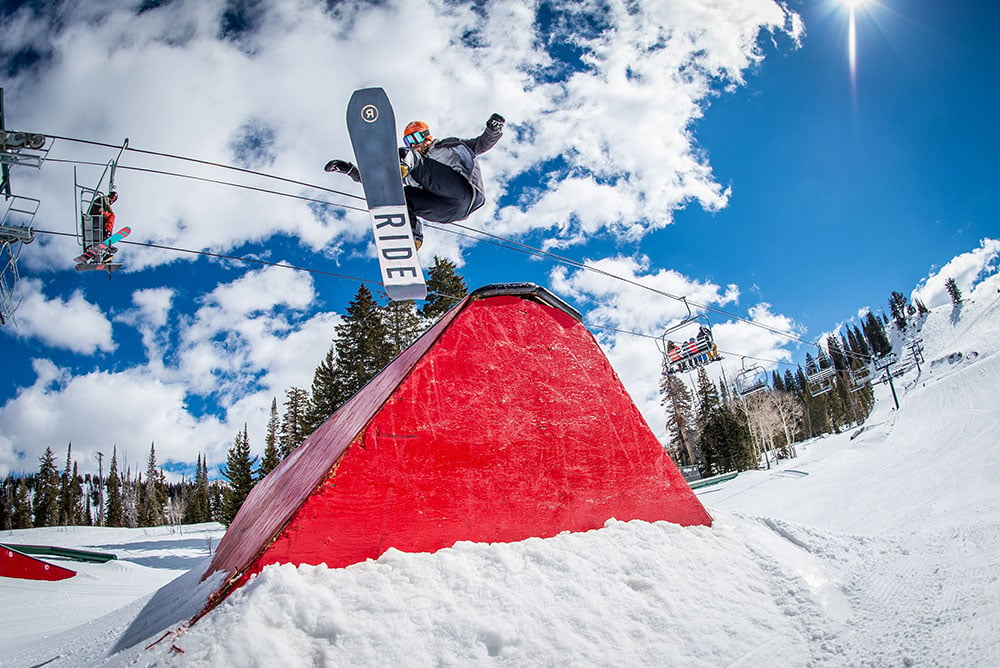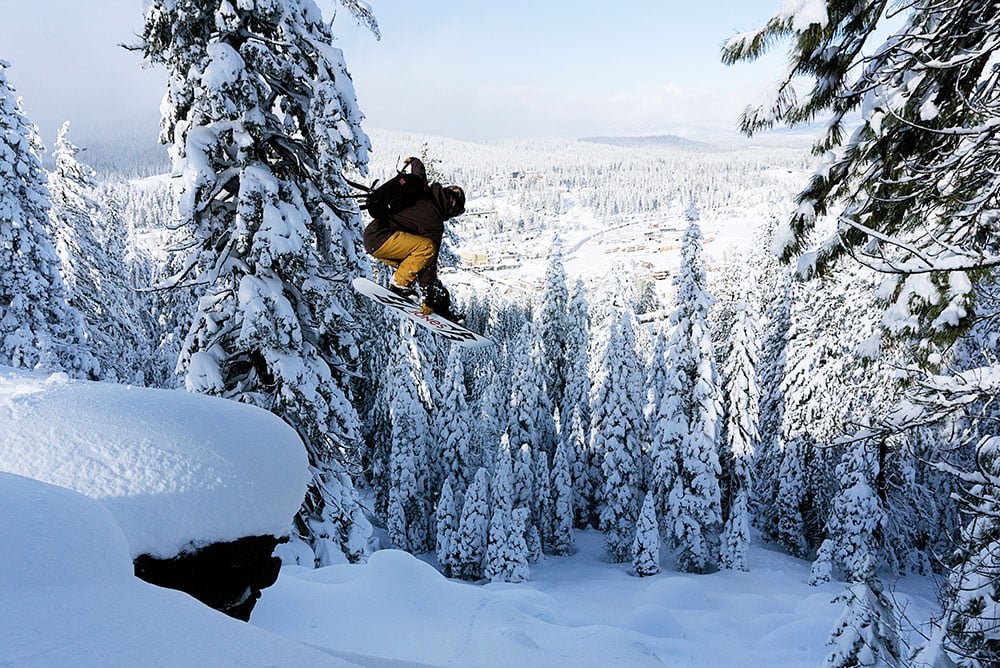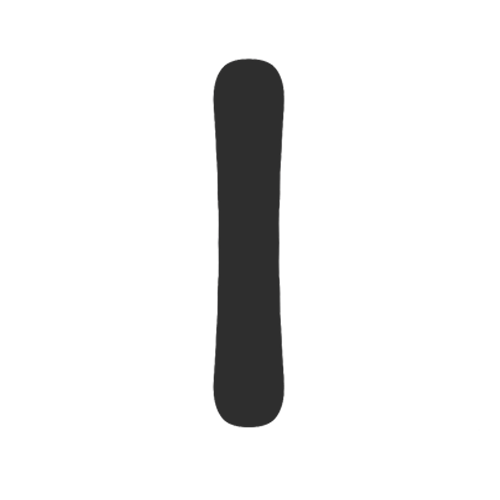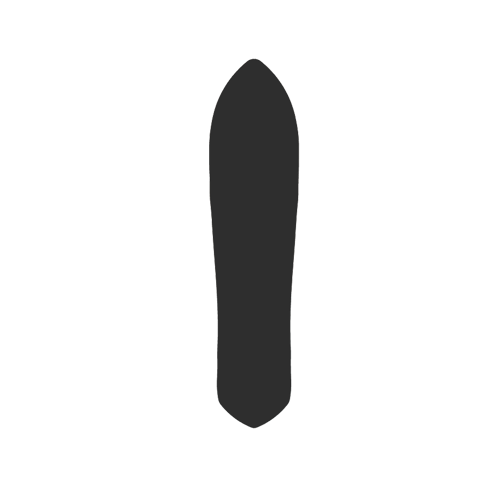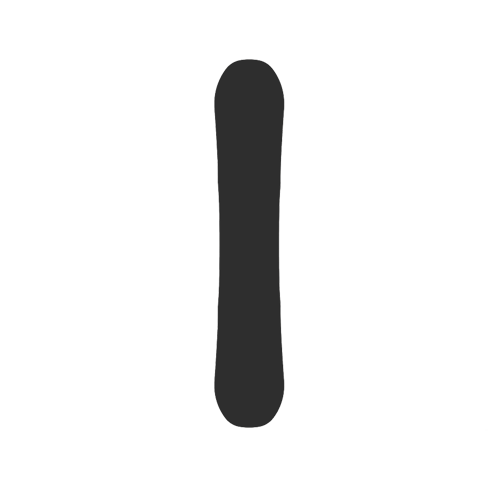How to Choose a Snowboard & Snowboard Size Chart
There is a ton of information floating around in the world of snowboarding, between rocker, effective edge to sidecuts and shapes - finding the right snowboard can sometimes be a little overwhelming. Thankfully evo has all you need to know to make the right decision. So whether you’re about to grab your first snowboard or your 15th, the essentials of finding the right snowboard for you boil down to the right width, the right length, and knowing which type of terrain you plan to be riding on. The rest can help you dial in the perfect board that will help you take your riding to a whole new level.
Contents
Anatomy of a Snowboard
What Size Snowboard Should I Get?
How do you pick the correct snowboard length? The length of your snowboard will vary depending on your body weight and the type of riding you plan to do. Back in the day, traditional snowboard sizing meant you stand next to the snowboard and if the top hits your chin, great, it fits! While that may be a good place to start, things like ability level, weight, and construction of the board are also important factors in determining the appropriate board length.
So, for example, if you are going to be mostly freeriding consider getting a slightly longer board for more stability and speed, unless you’re looking at a volume shifted board. If it's a freestyle snowboard you are looking for, consider smaller sizes that will be easier to spin and maneuver in the terrain park or half-pipe.
On each evo snowboard product detail page, you'll find individual size charts for each of the snowboards we sell. Remember, the length is as much personal preference as anything, so don’t get too hung up on the recommendations if you ride a longer or shorter board and are happy with it. Use our Snowboard Size Chart below for a starting point:
Additionally, consider the following factors when deciding on a snowboard size:
- If you're riding primarily in the park or freestyle, pick a board on the shorter end of the size range.
- If you're riding is mostly all mountain, powder or freeriding, consider a snowboard on the longer end of the size range or grabbing a volume shifted board.
- If you are above average weight consider a longer snowboard.
- If you are a beginner, aim for a shorter board in your size range.
Snowboard Size Chart
Click your snowboard size to shop
| Rider Height | Rider Weight | Snowboard Size (cm) | ||
| ft/in | cm | lb | kg | |
| 4'10" | 147 | 100-120 | 45-54 | 132-148 |
| 5' | 152 | 110-130 | 52-59 | 138-152 |
| 5'2" | 158 | 120-140 | 54-63 | 140-155 |
| 5'4" | 163 | 130-150 | 59-68 | 142-158 |
| 5'6" | 168 | 140-160 | 63-73 | 145-160 |
| 5'8" | 173 | 150-170 | 68-77 | 148-162 |
| 5'10" | 178 | 160-185 | 73-84 | 150-162 |
| 6' | 183 | 170-195 | 77-88 | 152-164 |
| 6'2" | 188 | 180-210 | 82-95 | 155-166 |
| 6'4" | 193 | 190+ | 86+ | 158+ |
Shop Snowboards by Length
How Wide Should My Snowboard Be?
When a snowboard waist width is sized correctly your snowboard boots will hang over the edges of the snowboard just slightly but not so much as to hit the snow when the board is on edge (see the images below). Extending the toes and heels slightly over the edges of the snowboard allows you to apply leverage to the board and modulate pressure with your ankles. If your boots extend too far over the edge, they’ll hit the snow during hard turns and cause you to fall. To determine the proper snowboard waist width for your snowboard boot size view the chart below.
Snowboard boot sizes vary by manufacturer and even by model within a single manufacturer's line, so the outer sole of manufacturer A's size 11 might be slightly longer than the outer sole of manufacturer B's size 11. Similarly, some boots are specifically built with a low profile. The shorter outsoles of a low profile boot allow a rider to ride a narrower snowboard. Additionally, the ramp angle on snowboard bindings partially determines how large of a boot you can put on a particular snowboard - more ramp angle means a boot will sit higher and fit on a narrower board.
What Type of Snowboard Should I Get?
What type of terrain will you be riding in? What is your ability level? What is your own personal preference? While you can ride any type of snowboard on any terrain, many boards are designed for you to get the most out of your session. It's easy to get lost in the plethora of options, so checking out this basic breakdown of board styles will help you find a board that works for you.
All Mountain Snowboards
All-mountain snowboards are designed to work well in all snow conditions and terrain. They are at home on groomers, powder, park runs or almost anything in between, and are notorious for their versatility. If you’re just getting started or are unsure of exactly what you need, an all-mountain snowboard is a great choice.
Freestyle Snowboards
Freestyle or park snowboards tend to be a bit shorter in length and love terrain parks, rails, jibs, trash cans, tree trunks, riding switch (non-dominant foot forward), wall rides and more. Freestyle boards often feature a true twin or asymmetrical shape, and are typically selected by those looking to ride the terrain park. A more versatile variant of a freestyle board is the all-mountain freestyle, which combines the versatility of an all mountain snowboard with the playfulness of a freestyle snowboard.
Freeride Snowboards
Freeride snowboards are designed for the rider who spends most of their time off groomed runs and in varied terrain. They typically have a stiffer flex and are ridden in longer sizes than freestyle snowboards. Freeride snowboards often feature a directional shape that is designed to perform optimally in one direction.
Powder Snowboards
Powder snowboards live for the deep stuff. They're designed to make the most of fresh conditions and usually have a wider nose and a tapered narrower tail. The binding inserts, which determine the rider's stance, are often set back on a powder snowboard, for flotation and steering with your back foot. Powder snowboards often feature generous rocker, a design element where the tip (and tail) rise starts farther back on the board, which also helps the rider float and pivot easily.
Splitboards
Designed for the backcountry rider, splitboards break down into two separate halves for uphill travel with climbing skins. Special bindings are required as well. Once you've reached the top, you reconnect the two halves for the ride downhill and ride normally. Appropriate avalanche safety skills and equipment plus knowledge of the terrain, weather and snow conditions are key when you head out on your splitboard.
Ability Level
What is your ability level? There are snowboards designed for every ability level, each addressing specific rider needs. Flex, shape, length, construction, materials, design, and intended use are all important when crafting a snowboard for a particular ability level. Be realistic in assessing your own ability when researching and selecting a new snowboard. Finding the right snowboard for your personal attributes, including your ability will help make your riding experience more enjoyable and help speed your progression.
Brands are consistently evolving and experimenting with their boards and offer new profiles nearly every year. Which profile you choose is entirely up to your personal preference and many people have different boards for the different types of riding they will do. For more information, check out our rocker guide.
Snowboard Flex
The amount a snowboard flexes varies significantly between boards. Snowboard flex ratings are not necessarily standardized across the industry, so a "medium" flex may vary from brand to brand. Many manufacturers will give a number rating ranging from 1-10, 1 being softest and 10 being stiffest. Here at evo we have standardized the manufacturers' number ratings as a feel rating ranging from soft to very stiff. Generally we classify flex ratings of 1-2 as soft, 3-5 as medium, 6-8 as stiff, and 9-10 as very stiff. Flex ratings and feel may ultimately vary from snowboard to snowboard.
Softer Flex
Softer flexing snowboards (typically freestyle and some all mountain snowboards) are going to be more forgiving and easier to turn. A soft flex is good for beginners, riders with lower body weights and park riders. Soft snowboards tend to be a bit looser at higher speeds but can also provide a soft buttery feel at slower speeds.
Stiffer Flex
Stiffer flexing snowboards are usually built for freeride or backcountry use. They provide better edge hold and are more stable at high speeds. Stiff boards can be great for riders laying down high speed turns but tough for lightweight riders to flex properly.
Sintered Snowboard Base vs Extruded Base
Extruded snowboard bases are made from polyethylene (often called P-Tex). The term extruded refers to the process of heating and forming the material into sheets in the manufacturing process. Extruded P-Tex is relatively inexpensive. These bases do not hold wax as well as sintered bases, and so they can be slower than a well-tuned sintered base. However, an extruded base can perform better than an unwaxed sintered base and are very durable.
Sintered snowboard bases are designed for super-fast glide. Like extruded bases, sintered bases are made from polyethylene (P-Tex). But unlike extruded bases, sintered bases are produced by compressing tiny pellets of polyethylene rather than melting and pushing it out in a sheet. Sintered bases are very porous and absorb wax well. When waxed and maintained properly, they are much faster than extruded bases. Often additional materials such as Gallium, graphite or Indium are added to the bases to provide increased impact resistance, durability and glide. Sintered bases are typically more expensive and can be more difficult to repair than extruded bases.
Durability and Price Range
Price is almost always a consideration when shopping. At evo we are very selective of the snowboards we sell. We strive to always offer quality products at the best prices, but there is a huge range of choices and prices. Details like the type of wood used in the core, type of laminates used in the layup, quality of base material and edges, and how all these elements are put together in a board affect both its ride and durability. Quality materials and advanced design cost money. If you plan to ride your snowboard for multiple seasons or ride many days in a year, spending a little more for quality and durability is always worth it.Snowboard Hole Patterns and Binding Compatability
There are four different snowboard hole patterns that you will find on conventional snowboards. The patterns include: 4x4, 2x4, Burton 3D and Burton Channel. 3D and Channel technology are specific to Burton Snowboards, although some board makers have begun licensing Channel technology from Burton. 2x4 is a variation of 4x4 that gives the rider more mounting options.
Universal Disc
A while back the world of snowboarding was graced with a universal disc. These days most bindings come stocked with this piece and will allow you to attach almost any pair of bindings to any board. Always check to see if the binding you're purchasing come with a universal disc or a mini disc, if you have an older 4x4 board a mini disc won't work with your board. Check our binding guide to ensure you're getting a setup that works for you.
Women's Snowboards
For years snowboard companies simply sized down men’s snowboards and applied pretty pink graphics featuring flowers and animals to them. Not anymore! Companies have created women-specific focus groups, beefed up their women’s pro teams and created snowboards specifically for women based on their feedback. Women’s bodies and turn mechanics are different than men. Since women tend to have less body mass and smaller feet than men of the same height, women’s snowboards tend to have narrower waist widths, thinner profiles, and softer flexes.
Kids' Snowboards
As much as you want to buy a snowboard your child can grow into, it is important to find a snowboard that will work for him or her now. Do you want your kid to love the sport? We thought so. The correct size snowboard will help your child progress faster and have a lot more fun in the process. Kids’ snowboards are typically softer than adult snowboards making it easier for kids to initiate turns and learn to ride. For more information, check out our kids snowboard size guide.
Testing & Renting Skis & Snowboards
It’s easy to obsess over every measurement and material of different ski and snowboard models when looking at them on a computer screen, but there is absolutely no substitute for some real-time on the snow. So, once you’ve narrowed down the candidates and you’re ready to choose your next model, it’s time to get on snow. Renting or demoing skis and snowboards is the only true way to get a feel for how they ride, and if they suit you.
Check out evoRentals, our industry-leading ski and snowboard rental experience at our locations, which offers a wide variety of the latest models.
Learn More With Our Other Snowboard Guides:
Snowboards - Snowboard Buyers Guide
Snowboards - Snowboard Rocker Explained
Snowboards - Kids' Snowboards Size Chart
Snowboards - How to Choose a Freestyle Park Setup
Snowboards - How to Choose Snowboard Shapes
Asymmetrical Snowboard Shapes
Snowboard Boots - How to Choose & Fit
Snowboard Boots - How to Put on & Fit
Snowboard Bindings - How to Choose & Compatibility
Snowboard Bindings – How To Set Up
How to Wax a Snowboard
Outerwear - What to Wear Snowboarding
Outerwear - How to Wash & Waterproof
Outerwear - Regional Snowboard Guide
Goggles - How to Choose
Goggles - Wearing Goggles with Glasses
Helmets - How to Choose & Fit Guide
Gloves & Mittens - How to Choose
Socks - How to Choose Snowboard Socks
Footbeds - How to Choose
Snowboarding - How to Get in Shape
Travel - How to Fly with Snowboards
Splitboarding - How to Get Started
Splitboarding - Board and Binding Weight Chart
Avalanche Probes - How to Choose
Backcountry - Choosing an Avalanche Airbag Pack
Backcountry - Choosing an Avalanche Beacon
Backcountry - Climbing Skins Size Guide
Backcountry - How to Choose an Avalanche Shovel
Backcountry - How to Choose Climbing Skins
Backcountry Backpacks - How to Choose
Backcountry Basics - How to Get Started
This is evo. We are a ski, snowboard, wake, skate, bike, surf, camp, and clothing online retailer with physical stores in Seattle, Portland, Denver, Salt Lake City, Whistler, and Snoqualmie Pass. Our goal is to provide you with great information to make both your purchase and upkeep easy.
evo also likes to travel to remote places across the globe in search of world-class powder turns, epic waves, or legendary mountain biking locations through evoTrip Adventure Travel Trips. Or, if you prefer to travel on your own, check out our ski & snowboard resort travel guides and mountain bike trail guides.
Still have questions? Please call our customer care team at 1.866.386.1590 during Customer Care Hours. They can help you find the right setup to fit your needs.
